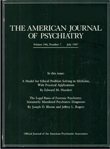Cerebrospinal fluid monoamine metabolites in childhood-onset schizophrenia
Abstract
OBJECTIVE: Pediatric studies of cerebrospinal fluid (CSF) monoamine metabolites in childhood-onset schizophrenia may help to elucidate both pathophysiology and treatment response in early-onset psychosis. METHOD: CSF homovanillic acid (HVA), 5-hydroxyindoleacetic acid (5- HIAA), and 3-methoxy-4-hydroxyphenylglycol (MHPG) and serum prolactin were measured during drug-free and antipsychotic medication conditions in 18 patients (mean age = 14.2 years, SD = 1.7) who had onset of schizophrenia by age 12 (mean age at onset = 9.9 years, SD = 1.8). Relationships between changes in CSF monoamines and serum prolactin and clinical outcome were examined, and the degree of change in CSF monoamines in response to clozapine treatment was compared with that for 16 patients with later-onset schizophrenia. RESULTS: Despite patients' significant clinical improvement with treatment, CSF monoamine concentrations and ratios of HVA/5-HIAA and HVA/MHPG did not significantly change with 6 weeks of either haloperidol or clozapine treatment. Serum prolactin levels increased during haloperidol treatment. Clozapine had similar effects on CSF monoamines in patients with childhood- and later-onset schizophrenia. CONCLUSIONS: While these data are compatible with continuity between childhood- and later-onset schizophrenia, they also highlight the complexity of the biochemical events mediating clinical changes in schizophrenia.



